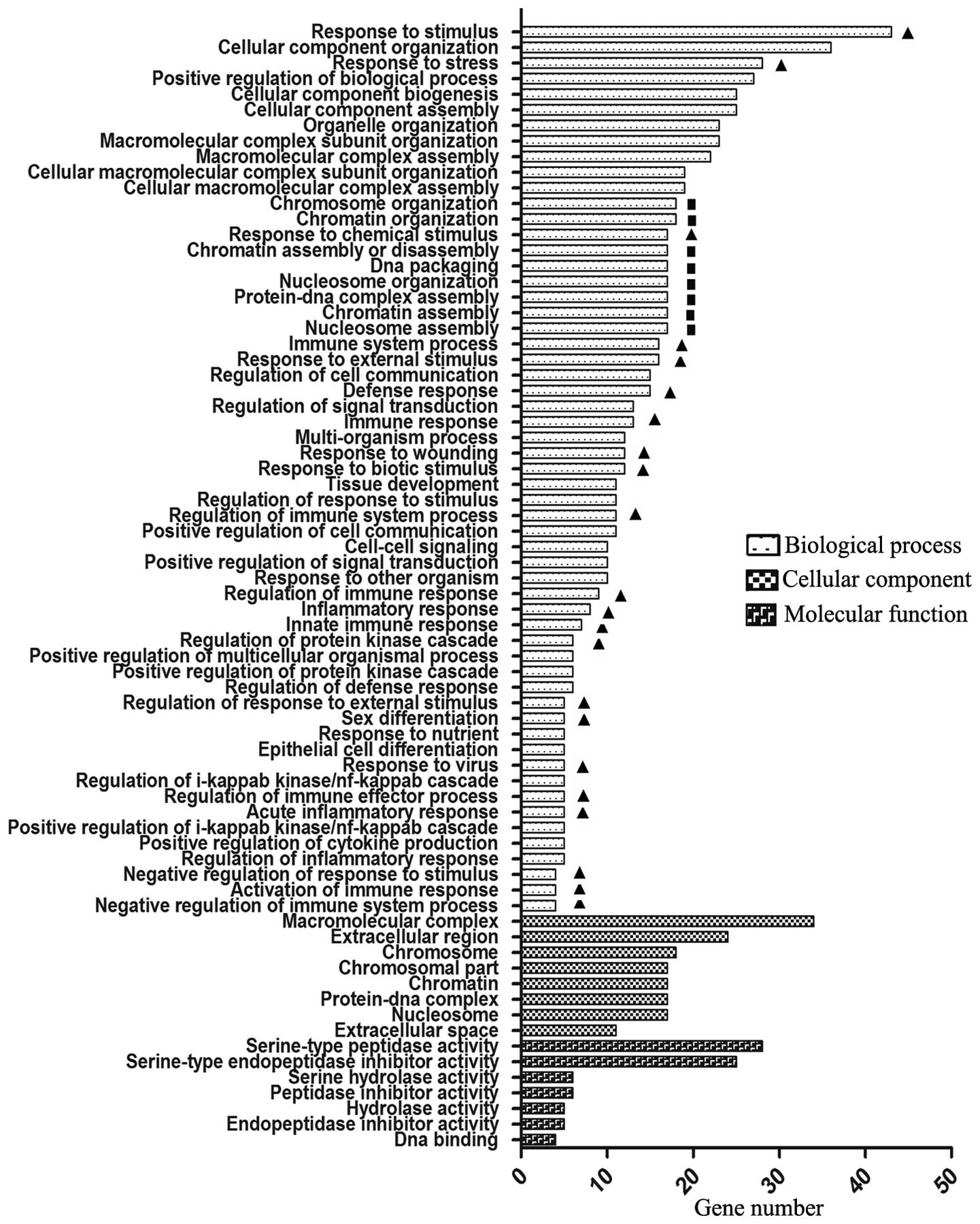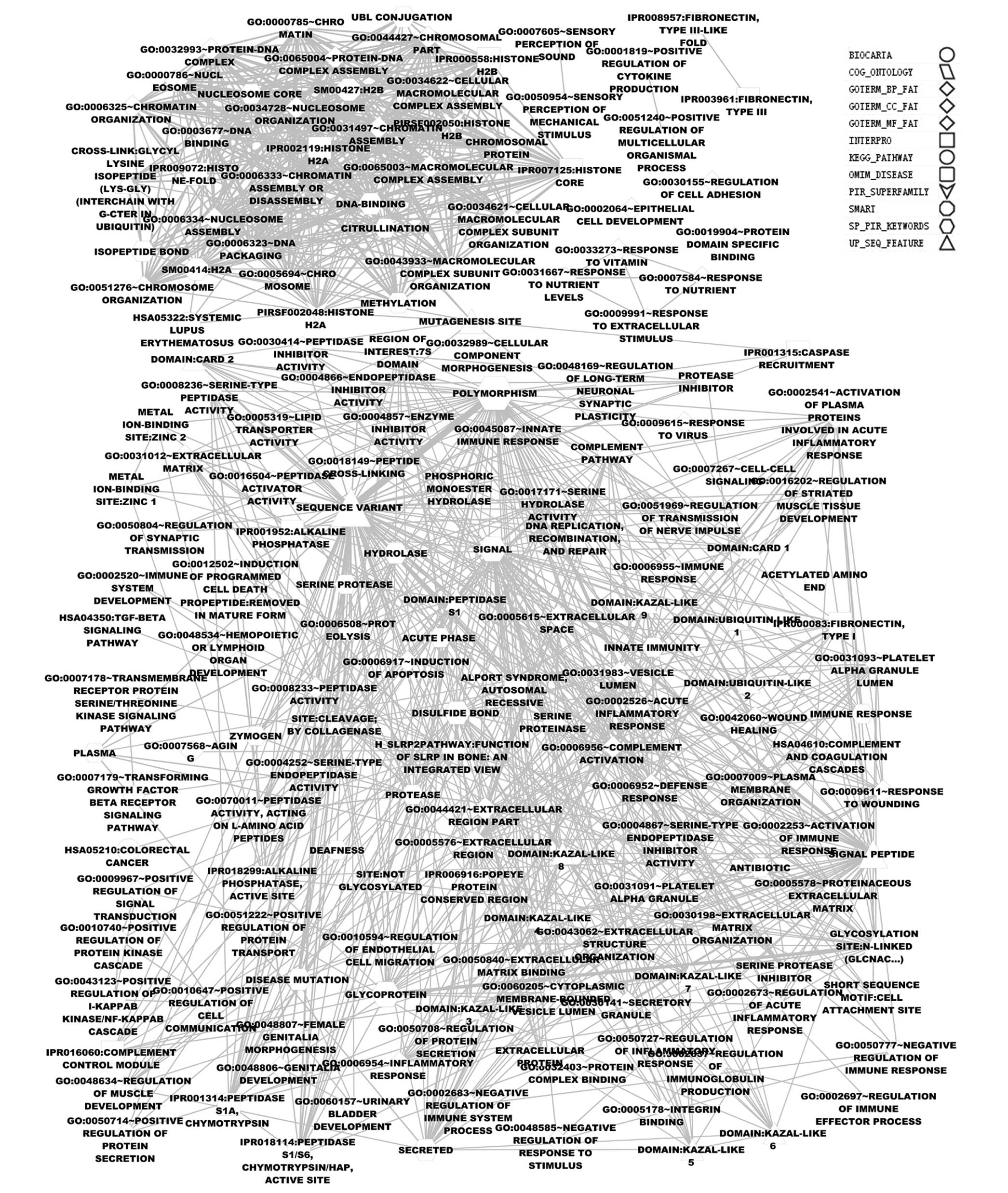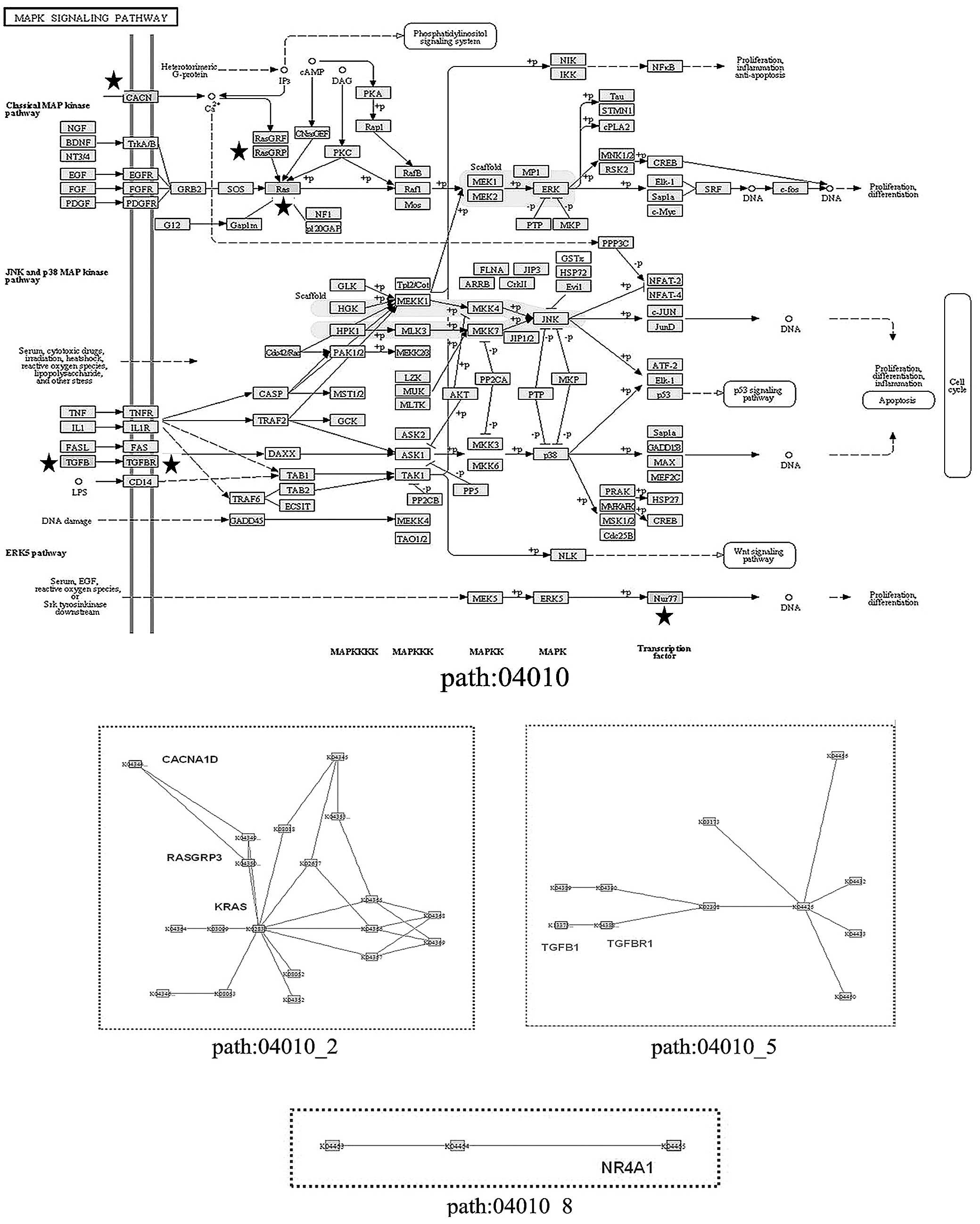|
1
|
Flower DR: The lipocalin protein family:
structure and function. Biochem J. 318:1–14. 1996.
|
|
2
|
Yan L, Borregaard N, Kjeldsen L and Moses
MA: The high molecular weight urinary matrix metalloproteinase
(MMP) activity is a complex of gelatinase B/MMP-9 and neutrophil
gelatinase-associated lipocalin (NGAL). Modulation of MMP-9
activity by NGAL. J Biol Chem. 276:37258–37265. 2001. View Article : Google Scholar : PubMed/NCBI
|
|
3
|
Yang J, Goetz D, Li JY, et al: An iron
delivery pathway mediated by a lipocalin. Mol Cell. 10:1045–1056.
2002. View Article : Google Scholar : PubMed/NCBI
|
|
4
|
Chakraborty S, Kaur S, Guha S and Batra
SK: The multifaceted roles of neutrophil gelatinase associated
lipocalin (NGAL) in inflammation and cancer. Biochim Biophys Acta.
1826.129–169. 2012.PubMed/NCBI
|
|
5
|
Zhang H, Xu L, Xiao D, et al: Upregulation
of neutrophil gelatinase associated lipocalin in oesophageal
squamous cell carcinoma: significant correlation with cell
differentiation and tumour invasion. J Clin Pathol. 60:555–561.
2007. View Article : Google Scholar
|
|
6
|
Du ZP, Lv Z, Wu BL, et al: Neutrophil
gelatinase-associated lipocalin and its receptor: independent
prognostic factors of oesophageal squamous cell carcinoma. J Clin
Pathol. 64:69–74. 2011. View Article : Google Scholar : PubMed/NCBI
|
|
7
|
Hu L, Hittelman W, Lu T, et al: NGAL
decreases E-cadherin- mediated cell-cell adhesion and increases
cell motility and invasion through Rac1 in colon carcinoma cells.
Lab Invest. 89:531–548. 2009. View Article : Google Scholar : PubMed/NCBI
|
|
8
|
Iannetti A, Pacifico F, Acquaviva R, et
al: The neutrophil gelatinase-associated lipocalin (NGAL), a
NF-kappaB-regulated gene, is a survival factor for thyroid
neoplastic cells. Proc Natl Acad Sci USA. 105:14058–14063. 2008.
View Article : Google Scholar
|
|
9
|
Tong Z, Kunnumakkara AB, Wang H, et al:
Neutrophil gelatinase- associated lipocalin: a novel suppressor of
invasion and angiogenesis in pancreatic cancer. Cancer Res.
68:6100–6108. 2008. View Article : Google Scholar : PubMed/NCBI
|
|
10
|
Wu B, Li C, Du Z, et al: Network based
analyses of gene expression profile of LCN2 overexpression in
esophageal squamous cell carcinoma. Sci Rep. 4:54032014.PubMed/NCBI
|
|
11
|
Huang da W, Sherman BT and Lempicki RA:
Systematic and integrative analysis of large gene lists using DAVID
bioinformatics resources. Nat Protoc. 4:44–57. 2009.PubMed/NCBI
|
|
12
|
Merico D, Isserlin R, Stueker O, Emili A
and Bader GD: Enrichment map: a network-based method for gene-set
enrichment visualization and interpretation. PLoS One.
5:e139842010. View Article : Google Scholar : PubMed/NCBI
|
|
13
|
Li C, Li X, Miao Y, et al:
SubpathwayMiner: a software package for flexible identification of
pathways. Nucleic Acids Res. 37:e1312009. View Article : Google Scholar : PubMed/NCBI
|
|
14
|
Kankainen M and Holm L: POCO: discovery of
regulatory patterns from promoters of oppositely expressed gene
sets. Nucleic Acids Res. 33(Web Server issue): W427–W431. 2005.
View Article : Google Scholar : PubMed/NCBI
|
|
15
|
Jefferson JA, Lemmink HH, Hughes AE, et
al: Autosomal dominant Alport syndrome linked to the type IV
collage alpha 3 and alpha 4 genes (COL4A3 and COL4A4). Nephrol Dial
Transplant. 12:1595–1599. 1997. View Article : Google Scholar : PubMed/NCBI
|
|
16
|
He J, Gu D, Wu X, et al: Major causes of
death among men and women in China. N Engl J Med. 353:1124–1134.
2005. View Article : Google Scholar : PubMed/NCBI
|
|
17
|
Pérez-Castro AJ and Freire R: Rad9B
responds to nucleolar stress through ATR and JNK signalling, and
delays the G1-S transition. J Cell Sci. 125:1152–1164.
2012.PubMed/NCBI
|
|
18
|
Prado-Montes de Oca E: Human beta-defensin
1: a restless warrior against allergies, infections and cancer. Int
J Biochem Cell Biol. 42:800–804. 2010.PubMed/NCBI
|
|
19
|
Goetz DH, Willie ST, Armen RS, et al:
Ligand preference inferred from the structure of neutrophil
gelatinase associated lipocalin. Biochemistry. 39:1935–1941. 2000.
View Article : Google Scholar : PubMed/NCBI
|
|
20
|
Godinez I, Haneda T, Raffatellu M, et al:
T cells help to amplify inflammatory responses induced by
Salmonella enterica serotype Typhimurium in the intestinal
mucosa. Infect Immun. 76:2008–2017. 2008. View Article : Google Scholar : PubMed/NCBI
|
|
21
|
Nairz M, Fritsche G, Brunner P, et al:
Interferon-gamma limits the availability of iron for
intramacrophage Salmonella typhimurium. Eur J Immunol.
38:1923–1936. 2008. View Article : Google Scholar : PubMed/NCBI
|
|
22
|
Rodríguez N, Mages J, Dietrich H, et al:
MyD88-dependent changes in the pulmonary transcriptome after
infection with Chlamydia pneumoniae. Physiol Genomics.
30:134–145. 2007.PubMed/NCBI
|
|
23
|
Martineau AR, Newton SM, Wilkinson KA, et
al: Neutrophil- mediated innate immune resistance to mycobacteria.
J Clin Invest. 117:1988–1994. 2007. View Article : Google Scholar : PubMed/NCBI
|
|
24
|
Noto A, Cibecchini F, Fanos V and Mussap
M: NGAL and metabolomics: the single biomarker to reveal the
metabolome alterations in kidney injury. Biomed Res Int.
2013:6120322013. View Article : Google Scholar : PubMed/NCBI
|
|
25
|
Alharazy SM, Kong N, Saidin R, et al:
Serum neutrophil gelatinase-associated lipocalin and cystatin C are
early biomarkers of contrast-induced nephropathy after coronary
angiography in patients with chronic kidney disease. Angiology.
65:436–442. 2014. View Article : Google Scholar
|
|
26
|
Sohotnik R, Nativ O, Abbasi A, et al:
Phosphodiesterase-5 inhibition attenuates early renal
ischemia-reperfusion-induced acute kidney injury: assessment by
quantitative measurement of urinary NGAL and KIM-1. Am J Physiol
Renal Physiol. 304:F1099–F1104. 2013. View Article : Google Scholar
|
|
27
|
Soikkeli J, Podlasz P, Yin M, et al:
Metastatic outgrowth encompasses COL-I, FN1, and POSTN
up-regulation and assembly to fibrillar networks regulating cell
adhesion, migration, and growth. Am J Pathol. 177:387–403. 2010.
View Article : Google Scholar : PubMed/NCBI
|
|
28
|
Gruys E, Toussaint MJ, Niewold TA and
Koopmans SJ: Acute phase reaction and acute phase proteins. J
Zhejiang Univ Sci B. 6:1045–1056. 2005. View Article : Google Scholar : PubMed/NCBI
|
|
29
|
Li C, Shang D, Wang Y, et al:
Characterizing the network of drugs and their affected metabolic
subpathways. PLoS One. 7:e473262012. View Article : Google Scholar : PubMed/NCBI
|
|
30
|
Wu Y and Zhou BP: Snail: More than EMT.
Cell Adh Migr. 4:199–203. 2010. View Article : Google Scholar : PubMed/NCBI
|
|
31
|
Schmalhofer O, Brabletz S and Brabletz T:
E-cadherin, beta-catenin, and ZEB1 in malignant progression of
cancer. Cancer Metastasis Rev. 28:151–166. 2009. View Article : Google Scholar : PubMed/NCBI
|
|
32
|
Kuo KT, Chou TY, Hsu HS, Chen WL and Wang
LS: Prognostic significance of NBS1 and Snail expression in
esophageal squamous cell carcinoma. Ann Surg Oncol. 19 Suppl
3:S549–S557. 2012. View Article : Google Scholar : PubMed/NCBI
|
|
33
|
Ohashi S, Natsuizaka M, Naganuma S, et al:
A NOTCH3-mediated squamous cell differentiation program limits
expansion of EMT-competent cells that express the ZEB transcription
factors. Cancer Res. 71:6836–6847. 2011. View Article : Google Scholar : PubMed/NCBI
|
|
34
|
Smith VE, Franklyn JA and McCabe CJ:
Expression and function of the novel proto-oncogene PBF in thyroid
cancer: a new target for augmenting radioiodine uptake. J
Endocrinol. 210:157–163. 2011. View Article : Google Scholar : PubMed/NCBI
|
|
35
|
Batliner J, Buehrer E, Federzoni EA, et
al: Transcriptional regulation of MIR29B by PU.1 (SPI1) and MYC
during neutrophil differentiation of acute promyelocytic leukaemia
cells. Br J Haematol. 157:270–274. 2012. View Article : Google Scholar : PubMed/NCBI
|
|
36
|
Kjeldsen L, Johnsen AH, Sengeløv H and
Borregaard N: Isolation and primary structure of NGAL, a novel
protein associated with human neutrophil gelatinase. J Biol Chem.
268:10425–10432. 1993.PubMed/NCBI
|
|
37
|
Cowland JB and Borregaard N: Molecular
characterization and pattern of tissue expression of the gene for
neutrophil gelatinase-associated lipocalin from humans. Genomics.
45:17–23. 1997. View Article : Google Scholar
|
|
38
|
Chakravarty G, Moroz K, Makridakis NM, et
al: Prognostic significance of cytoplasmic SOX9 in invasive ductal
carcinoma and metastatic breast cancer. Exp Biol Med (Maywood).
236:145–155. 2011. View Article : Google Scholar : PubMed/NCBI
|













